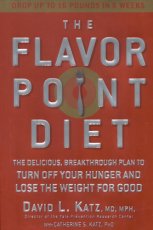 Excerpt
from The Flavor Point Diet: The Delicious, Breakthrough Plan to Turn Off Your Hunger and Lose the Weight for Good
Excerpt
from The Flavor Point Diet: The Delicious, Breakthrough Plan to Turn Off Your Hunger and Lose the Weight for Good
by David L. Katz, MD, MPH with Catherine S. Katz, PhD
Why We Overeat
The most important, prevalent, and powerful reason we eat and overeat is sensory delight: We do it because we see, smell, and taste food. You, along with every other human, have a sensory relay system that connects your mouth to your brain, your brain to your stomach, and your stomach back to your brain. Ultimately, your brain is in charge of your eating behavior. It controls what you eat and what you like to eat. As soon as you taste food, the sensory information registers in the hypothalamus in the brain, which, depending on the flavor of the food, sends out signals to eat more or eat less. Because of this sensory relay system, the appetite center in your hypothalamus can become aroused -- and in some cases overly aroused -- by how a food tastes.
To learn how to work with your appetite center, you must first understand it. It's time for you and your brain to become better acquainted.
As soon as you bite into any food, sensory stimulation of nerve endings on the tongue leads to the release of a number of chemicals, including opioids, into the bloodstream. You release more opioids -- the body's natural versions of drugs like morphine -- when you consume foods high in sugar and fat, creating a powerful, neurochemical drive to overeat those foods. These opioids and other chemicals enter the bloodstream and carry their messages to the hypothalamus, which sends out yet another set of chemicals to regulate appetite. The more flavors your taste buds register, the more stimulated the hypothalamus becomes, releasing the hunger-promoting hormone neuropeptide Y. When you taste a lot of flavors at once, the brain releases a lot of neuropeptide Y.
Meanwhile, in response to the smell and taste of food, your stomach produces the hormone ghrelin, which also stimulates appetite. It continues to produce this hormone until you eat enough food to literally fill your stomach and stretch the stomach wall. Farther down the line, in your intestines, levels of several hormones rise to varying degrees -- depending on the nature of your meal -- either inducing more hunger or turning off hunger.
To understand how your food choices can influence this complex chain of events, let's take a closer look at how this all works by comparing the neurochemical response to two foods you might eat for breakfast: a sausage, egg, and cheese English muffin sandwich and a bowl of oatmeal.
In the mouth: The mix of sugar, fat, and salt in the egg sandwich triggers the release of more opioids than the oatmeal does. These opioids create a powerful, neurochemical drive to eat more sandwich.
In the brain: The sandwich's sausage, cheese, and muffin offer many varied tastes, causing neuropeptide Y -- and hunger -- to surge. The simple flavors of the oatmeal result in the release of much less neuropeptide Y.
In the stomach: The sandwich delivers a lot of calories in a small package. It doesn't stimulate the stomach's stretch receptors nearly as quickly as the oatmeal, allowing ghrelin levels to remain high long after you've overeaten. You must eat many more egg sandwich calories than oatmeal calories before the stomach wall registers fullness.
In the intestines: The highly processed sandwich bread less effectively suppresses hunger-producing hormones than does the oatmeal, again leaving you feeling hungry despite the abundance of calories.
In the bloodstream: The stomach and intestines quickly convert the simple starch and sugar in the white bread into glucose, or blood sugar. The glucose seeps through the intestinal wall and into the bloodstream, sending blood sugar levels up. In response, the pancreas overproduces insulin, which moves glucose from the blood into muscles and other tissues. The insulin quickly drives down blood sugar, leading to more hunger.
On the other hand, the fiber in the oatmeal dissolves in water inside the intestines, where it creates a barrier through which nutrients must pass to get into the bloodstream, thus slowing the entrance of glucose into the blood. The result is a slower, lower rise in blood sugar; a slower release of insulin; no rapid surge and dip in blood sugar levels; and lasting fullness.
As you can see, what you eat has a powerful ability to influence how much you must eat to feel full and satisfied. You can't think yourself thin, as some books in the past have claimed. But by organizing the flavors in your foods, you can manipulate this complex series of chemicals and subdue the appetite center in your brain sooner, before you've overeaten.
Reprinted from: The Flavor Point Diet: The Delicious, Breakthrough Plan to Turn Off Your Hunger and Lose the Weight for Good by David L. Katz, MD, MPH © 2005 David L. Katz. Permission granted by Rodale, Inc., Emmaus, PA 18098. Available wherever books are sold or directly from the publisher by calling (800) 848-4735 or visit their website at www.rodalestore.com.
